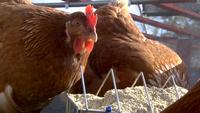Chicken Feed Supplement Study
Black Soldier Fly Larvae Chicken Feed Supplement Study
Maurice Pitesky, UC Cooperative Extension poultry specialist with UC Davis School of Veterinary Medicine and UC Agriculture and Natural Resources, Deb Niemeier professor from the Department of Civil and Environmental Engineering and Jean VanderGheynst professor in the Department of Biological Agricultural Engineering are leading a research project to determine whether feeding egg-laying hens a diet supplemented with black soldier fly larva (BSFL) will cause their eggs to taste or look different. This poultry project may lead to improved poultry health while reducing the amount of corn and soy used in chicken feed.
Why do organic chickens need a dietary supplement?
Adequate methionine levels in poultry has been associated with proper development, improved egg production and overall improvement in bird health. To meet the protein and specific amino acid requirements of feeding organic poultry, USDA organic rules currently allow farmers to add the synthetic amino acid methionine to organic poultry feed in limited amounts. Specifically, USDA’s organic regulations currently allow synthetic methionine at two pounds per ton of feed, but there have been recent indications that synthetic methionine will be phased out as a feed supplement for organic poultry.
Adding fishmeal to poultry feed is one means of replacing synthetic methionine and has been widely studied as a means to address amino acid deficiencies. But there are drawbacks to using fishmeal. In North America, when used at the levels needed to balance the dietary amino acids, fishmeal is cost-prohibitive and the fishmeal imparts a fishy taste to the meat and eggs.
Insects are more cost-effective
Bird eat insects anyway so the researchers are using black soldier fly larvae (BSFL) as a natural way to boost methionine. The larvae are produced in VanderGheynst’s lab on campus and also purchased from commercial sources. The BSFL are processed, dried and ground into the chicken feed.
Researchers will have consumers taste test eggs from chickens that have received feed containing 20 percent, 15 percent, 10 percent and 5 percent BSFL to see if the BSFL supplement affects the eating experience. If, for example, 20 percent of the corn and soy in chicken feed could be replaced with BSFL, the corn and soy saved could be diverted for other uses including biofuels and additional calories for humans.
The experiment is being supported by the Methionine Task Force, which represents organic poultry producers across the U.S.
The collaborative project involves UC Davis Dining Services, Animal Science, School of Veterinary Medicine, Bio-Ag Engineering, Civil Engineering, graduate student Lydia Palma and approximately 10 animal science and engineering undergraduate students.
Click on the thumbnail to view the short clips of our current Pastured Poultry Flock!
|
Egg Collection |
Egg Collection |
Egg Collection |
Eggs |
| Eggs |
Eggs |
Shade |
Shade |
| Coop Set-up |
Coop |
Chicken |
Chicken |
| Foraging |
Foraging |
Foraging |
Foraging |
| Foraging |
Foraging |
Eating from Feeders |
Eating from Feeders |
| Eating from Feeders |
Eating from Feeders |
Eating from Feeders |
Eating from Feeders |
| Feeding Time |
Feed |
Almond Hulls |
Incubator Bags |
| Freeze Dried Larvae |
Burrowing Larvae |
Burrowing Larvae |
Larvae in Bag |
| Larvae in Bag |
Larvae in Tub |
Larvae Production |
Measuring Larvae |
| Harvesting Larvae |
Larvae |
Larvae |













































